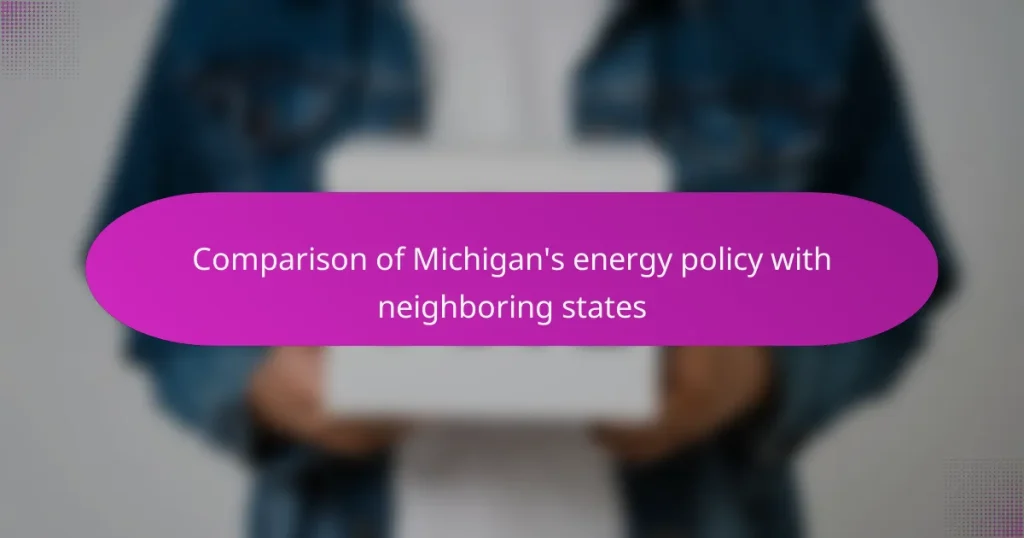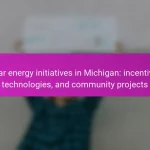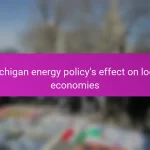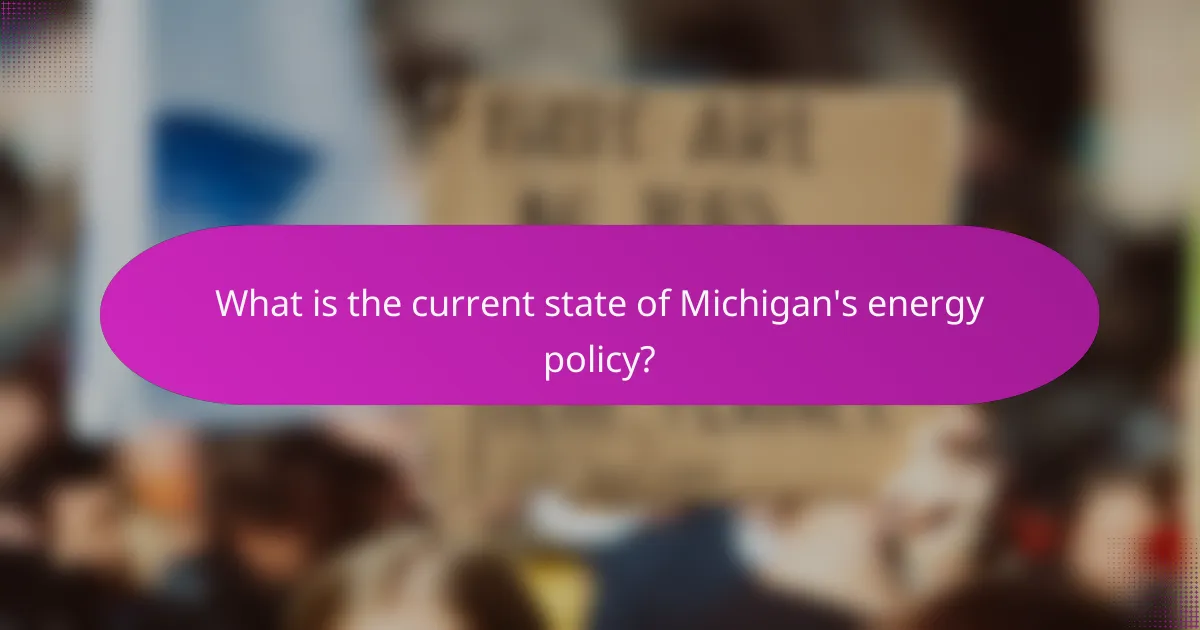
What is the current state of Michigan’s energy policy?
Michigan’s energy policy currently emphasizes renewable energy, energy efficiency, and reducing greenhouse gas emissions. The state aims for 50% of its energy to come from renewable sources by 2030. This aligns with the broader goal of achieving carbon neutrality by 2050. The Michigan Public Service Commission oversees the implementation of these policies. Recent legislation has also focused on expanding access to clean energy technologies. Additionally, Michigan’s energy policy encourages electric vehicle adoption and infrastructure development. These initiatives are part of a comprehensive strategy to modernize the state’s energy grid.
How does Michigan’s energy policy compare to those of its neighboring states?
Michigan’s energy policy focuses on renewable energy and energy efficiency, similar to its neighboring states. Michigan has a renewable portfolio standard (RPS) requiring 15% of energy from renewable sources by 2021. In comparison, Illinois has a more aggressive RPS of 25% by 2025. Ohio’s policy is less stringent, with a freeze on its RPS since 2014. Indiana also lags with no formal RPS, relying heavily on coal. Wisconsin promotes renewable energy but lacks a formal RPS. Michigan’s energy efficiency initiatives aim for a 2% reduction in electricity sales annually, which aligns with efforts in Illinois and Wisconsin. Overall, Michigan’s policies are more progressive than Ohio and Indiana but not as ambitious as Illinois.
What are the key components of Michigan’s energy policy?
Michigan’s energy policy focuses on renewable energy, energy efficiency, and reducing greenhouse gas emissions. The state aims for a 50% renewable energy standard by 2030. Energy efficiency programs target a 1% annual reduction in electricity usage. The policy also includes the integration of electric vehicles into the energy grid. Additionally, Michigan promotes distributed energy resources, including solar and wind power. The state has established a Clean Energy Plan to guide these initiatives. These components align with national trends towards sustainability and climate action.
Which neighboring states are being compared to Michigan?
The neighboring states being compared to Michigan are Ohio, Indiana, Illinois, Wisconsin, and Minnesota. These states share borders with Michigan and have varying energy policies. Each state’s approach to energy regulation and sustainability is analyzed in relation to Michigan’s policies. Comparisons often focus on renewable energy initiatives, energy efficiency programs, and regulatory frameworks. These elements highlight differences and similarities in energy strategies among the states.
What are the primary goals of Michigan’s energy policy?
The primary goals of Michigan’s energy policy include promoting renewable energy sources, enhancing energy efficiency, and ensuring reliable energy supply. Michigan aims to achieve a 50% reduction in greenhouse gas emissions by 2030. The state also seeks to increase the use of solar and wind energy significantly. Additionally, Michigan focuses on improving energy access and affordability for all residents. The policy encourages investment in clean energy technologies and infrastructure. These goals align with national efforts to combat climate change and transition to a sustainable energy future.
How does Michigan aim to achieve renewable energy targets?
Michigan aims to achieve renewable energy targets through a combination of legislation, investments, and incentives. The state’s Clean and Renewable Energy Act mandates that utilities obtain 15% of their energy from renewable sources by 2021. Additionally, Michigan has set a goal to achieve 50% renewable energy by 2030. The state promotes wind and solar energy projects through tax credits and grants. Furthermore, Michigan’s energy policy encourages public-private partnerships to enhance renewable energy infrastructure. The Michigan Public Service Commission oversees compliance and progress toward these targets. In 2020, Michigan generated over 15% of its electricity from renewable sources, demonstrating progress toward its goals.
What role does energy efficiency play in Michigan’s goals?
Energy efficiency is crucial for Michigan’s goals of reducing energy consumption and greenhouse gas emissions. It aims to lower energy costs for consumers and businesses. The state has set specific targets for energy savings through its energy efficiency programs. In 2020, Michigan’s energy efficiency programs achieved savings of over 1.5 billion kilowatt-hours. This aligns with Michigan’s broader goals of transitioning to a cleaner energy economy. Energy efficiency also supports job creation in the green sector. The state plans to enhance these initiatives to meet future energy demands sustainably. These efforts contribute to Michigan’s commitment to achieving carbon neutrality by 2050.

What are the historical influences on Michigan’s energy policy?
Michigan’s energy policy has been historically influenced by industrial growth, natural resource availability, and regulatory changes. The state’s early reliance on coal and natural gas shaped its energy landscape. The establishment of the Public Service Commission in 1939 marked a significant regulatory shift. The 1970s energy crisis prompted a reevaluation of energy sources and conservation efforts. In recent decades, renewable energy mandates have emerged due to environmental concerns. Legislation like the Clean, Renewable, and Efficient Energy Act of 2008 further transformed the energy policy framework. These historical factors collectively illustrate how Michigan’s energy policy evolved in response to economic, environmental, and regulatory pressures.
How have past energy crises shaped current policies?
Past energy crises have significantly influenced current energy policies. The oil embargo of the 1970s led to increased energy conservation measures. Governments prioritized energy independence and renewable energy development. The California energy crisis in 2000 prompted regulatory reforms to enhance grid reliability. Recent crises, such as the 2021 Texas winter storm, have spurred discussions on infrastructure resilience. These historical events have shaped policies to promote diversification of energy sources. They also emphasize the importance of emergency preparedness and response strategies. As a result, states like Michigan have adopted policies focusing on clean energy and sustainability.
What legislative changes have occurred in Michigan’s energy policy over the years?
Michigan’s energy policy has undergone several significant legislative changes over the years. In 2008, the state enacted the Energy Optimization Act, promoting energy efficiency and renewable energy. In 2016, the 21st Century Energy Policy Initiative was introduced to enhance the state’s energy infrastructure and promote clean energy. The Clean and Renewable Energy Standard was established, mandating that 15% of energy come from renewable sources by 2021. In 2019, the state passed legislation to increase energy efficiency standards for utilities and support renewable energy projects. These changes reflect Michigan’s evolving approach to energy, focusing on sustainability and reducing carbon emissions.
How have public opinions influenced energy policy decisions in Michigan?
Public opinions have significantly influenced energy policy decisions in Michigan. The state has seen a shift towards renewable energy sources due to growing public concern over climate change. Surveys indicate that a majority of Michigan residents support clean energy initiatives. This public sentiment has prompted lawmakers to prioritize renewable energy targets. In 2016, Michigan set a goal of achieving 15% renewable energy by 2021, reflecting public demand for sustainable energy solutions. Additionally, community engagement has led to local initiatives promoting energy efficiency. Public advocacy groups have played a crucial role in shaping policy discussions. Their efforts have resulted in increased transparency and accountability in energy planning. Overall, public opinion has been a driving force in Michigan’s energy policy landscape.
What lessons can be learned from neighboring states’ energy policies?
Neighboring states’ energy policies provide valuable lessons for Michigan. These policies often emphasize renewable energy adoption and efficiency measures. For instance, states like Illinois have implemented strong renewable portfolio standards. This has led to increased investment in solar and wind energy. Michigan can learn from their regulatory frameworks that support clean energy growth. Additionally, states such as Wisconsin focus on energy efficiency programs. These initiatives reduce overall energy consumption and lower costs for consumers. By analyzing these successful strategies, Michigan can enhance its energy policy to promote sustainability and economic benefits.
Which successful strategies from neighboring states could Michigan adopt?
Michigan could adopt renewable energy portfolio standards from Illinois. Illinois has a target of 25% renewable energy by 2025. This strategy has led to significant investments in solar and wind energy. Michigan could also implement energy efficiency programs similar to those in Wisconsin. Wisconsin’s Focus on Energy program has saved consumers millions in energy costs. Furthermore, Michigan might consider community solar initiatives like those in Minnesota. Minnesota’s community solar gardens have expanded access to solar energy for residents. These strategies have proven effective in neighboring states and could enhance Michigan’s energy policy.
What common challenges do neighboring states face in energy policy?
Neighboring states face several common challenges in energy policy. These challenges include regulatory inconsistencies, which create barriers for energy trade and investment. States may have differing standards for renewable energy sources. This inconsistency complicates cross-border energy projects. Additionally, neighboring states often compete for resources like natural gas and water. This competition can lead to conflicts over supply and pricing. Environmental regulations also vary, affecting how states manage emissions and sustainability efforts. Lastly, political differences can hinder collaborative initiatives aimed at improving energy infrastructure.
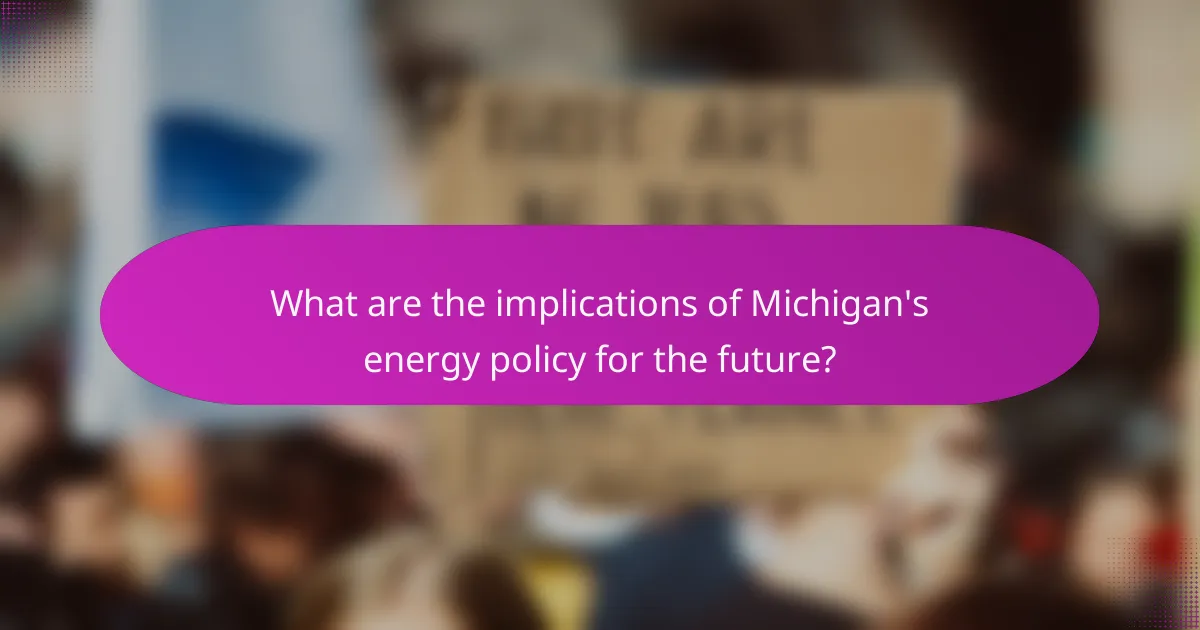
What are the implications of Michigan’s energy policy for the future?
Michigan’s energy policy aims to transition towards renewable energy sources. This shift could reduce greenhouse gas emissions significantly. The state has set a goal of achieving 50% renewable energy by 2030. This ambitious target aligns with national trends towards sustainability. Additionally, it may enhance energy independence for Michigan residents. The policy could also create thousands of jobs in the renewable energy sector. Investments in clean energy infrastructure are expected to stimulate economic growth. Overall, Michigan’s energy policy positions the state as a leader in the clean energy transition.
How might Michigan’s energy policy evolve in the next decade?
Michigan’s energy policy may evolve towards increased renewable energy adoption and stricter emissions regulations. The state has set a goal to achieve 50% renewable energy by 2030. This aligns with national trends and neighboring states’ commitments to clean energy. Michigan’s energy policy may also prioritize energy efficiency programs. These programs aim to reduce overall energy consumption and lower costs for consumers. In addition, the state is likely to invest in grid modernization to support renewable energy integration. Legislative measures may enhance incentives for solar and wind energy projects. The evolving policy landscape will be influenced by public demand for sustainable energy solutions.
What trends are emerging in energy policy across the Midwest?
Emerging trends in energy policy across the Midwest include a shift towards renewable energy sources and increased energy efficiency measures. States are setting ambitious renewable energy standards. For instance, Illinois aims for 100% clean energy by 2050. Additionally, many Midwest states are investing in solar and wind energy projects. This trend is supported by federal incentives and state-level initiatives. Energy storage solutions are also gaining traction to manage renewable energy supply. Furthermore, there is a growing emphasis on electric vehicle infrastructure. Overall, these trends indicate a regional commitment to sustainable energy practices.
How could changes in federal policy impact Michigan’s energy strategy?
Changes in federal policy could significantly impact Michigan’s energy strategy. Federal policies often dictate funding, regulations, and incentives for energy production and consumption. For instance, shifts towards renewable energy tax credits can encourage Michigan to invest more in solar and wind energy. Conversely, reduced federal support for clean energy could hinder Michigan’s transition to sustainable energy sources. Historical data shows that federal initiatives, such as the Clean Power Plan, have influenced state-level energy strategies across the U.S. Therefore, Michigan’s energy strategy remains closely tied to federal policy developments.
What practical steps can stakeholders take to influence Michigan’s energy policy?
Stakeholders can influence Michigan’s energy policy by actively engaging in public comment periods. They can submit feedback during hearings held by the Michigan Public Service Commission. Forming coalitions with other stakeholders amplifies their voice. Conducting research and presenting data-driven arguments can sway policymakers. Advocating for specific legislation through lobbying efforts is also effective. Hosting community forums raises public awareness and support. Collaborating with local governments to align energy goals can strengthen their position. Utilizing social media campaigns to mobilize public opinion further enhances their influence.
How can citizens participate in energy policy discussions?
Citizens can participate in energy policy discussions through public hearings and community forums. These platforms allow individuals to voice opinions and concerns directly to policymakers. Additionally, citizens can engage in advocacy by joining local environmental groups. These groups often organize campaigns to influence energy policies. Writing to elected officials is another effective method for citizens to express their views. This can include emails, letters, or phone calls urging specific policy changes. Social media also serves as a tool for raising awareness and mobilizing community support. Research by the National Renewable Energy Laboratory highlights that public engagement leads to more informed and effective energy policies.
What role do businesses play in shaping energy policy in Michigan?
Businesses in Michigan significantly influence energy policy through advocacy and investment. They engage in lobbying efforts to promote specific energy initiatives. Many companies push for renewable energy sources to align with sustainability goals. The Michigan Economic Development Corporation reports that businesses invested over $1 billion in clean energy projects in recent years. This investment helps shape policy frameworks that support renewable energy development. Furthermore, businesses often collaborate with state agencies to develop energy efficiency programs. Their participation ensures that policies reflect economic interests and technological advancements. Overall, the business sector plays a critical role in driving Michigan’s energy policy direction.
The primary entity of this article is Michigan’s energy policy, particularly its comparison with the energy policies of neighboring states such as Ohio, Indiana, Illinois, Wisconsin, and Minnesota. The article outlines Michigan’s goals to achieve 50% renewable energy by 2030, its emphasis on energy efficiency, and the role of the Michigan Public Service Commission in policy implementation. It also discusses historical influences, legislative changes, and public opinions that have shaped Michigan’s energy landscape, while analyzing the strengths and weaknesses of neighboring states’ policies. Additionally, the article highlights potential future trends and the involvement of stakeholders and businesses in influencing energy policy decisions.
